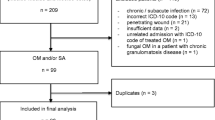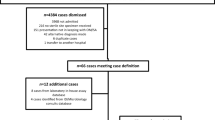Abstract
Background
Long bone posttraumatic osteomyelitis (PTOM) is a relatively common complication following surgical fixation of open fractures. There is a lacking consensus on ideal strategies for diagnostic evaluation of long bone PTOM. While open bone biopsy and culture is considered the ‘gold diagnostic standard,’ its cost and invasiveness are often prohibitive and have prompted the search for alternate diagnostic methods.
Objective
To evaluate the sensitivity and specificity of various diagnostic modalities relative to open bone biopsy and culture for the detection of long bone PTOM.
Design
Retrospective cohort study; Level of Evidence, III.
Setting
Urban Level I trauma center and safety-net institution.
Patients/participants
A consecutive cohort of 159 adult patients presenting with long bone PTOM at our Level I trauma center between January 1, 2004, and December 31, 2013, were retrospectively identified. All included patients fulfilled diagnostic criteria for PTOM (as defined by the Center for Disease Control and Prevention) that involved a long bone (femur, fibula, tibia, humerus, radius, and ulna). Patients with diabetic foot infection, septic arthritis, osteomyelitis of the spine/pelvis/hand, or insufficient medical records were excluded.
Main outcome measurements
Sensitivity and specificity of deep wound culture, soft tissue histopathologic examination, and elevated levels of acute phase reactants [C-reactive protein (CRP), erythrocyte sedimentation rate (ESR), and leukocyte count (WBC)] were determined using findings of open bone biopsy and culture as a reference standard.
Results
The most common pathogen isolated on open bone culture was staphylococci, contributing to 89 (57%) of 159 cases of long bone PTOM (p < 0.001). Relative to open bone biopsy and culture as the gold diagnostic standard, soft tissue histopathology demonstrated a sensitivity of 69.8% [95% confidence interval (CI) 53.7–82.3%] and specificity of 38.9% (95% CI 18.3–63.9%) for the detection of long bone PTOM. Deep wound culture exhibited a lower sensitivity of 66.0% (95% CI 56.1–74.8%) and specificity of 28.1% (95% CI 12.9–49.5%), a difference that was statistically significant (p = 0.021). Among inflammatory markers, elevated levels of CRP and ESR were equally sensitive for the detection of PTOM compared to open bone biopsy and culture, while WBC was significantly less sensitive (sensitivity 33.2%; 95% CI 25.3–43.7; p < 0.001).
Conclusion
Soft tissue histopathologic examination and deep wound culture are relatively poor substitutes for the diagnosis of long bone PTOM compared to open bone biopsy and culture. The accurate identification of causative pathogens underlying long bone PTOM is critical for diagnosis and choice of antibiotic treatment. Future studies investigating the use of higher-resolution diagnostic methods are merited.
Similar content being viewed by others
References
Patzakis MJ, Zalavras CG (2005) Chronic posttraumatic osteomyelitis and infected nonunion of the tibia: current management concepts. J Am Acad Orthop Surg 13:417–427
Zalavras CG, Christensen T, Rigopoulos N et al (2009) Infection following operative treatment of ankle fractures. Clin Orthop Relat Res 467:1715–1720
Calhoun JH, Manring MM, Shirtliff M (2009) Osteomyelitis of the long bones. Semin Plast Surg 23:59–72
Ikpeme IA, Ngim NE, Ikpeme AA (2010) Diagnosis and treatment of pyogenic bone infections. Afr Health Sci 10:82–88
Sanders J, Mauffrey C (2013) Long bone osteomyelitis in adults: fundamental concepts and current techniques. Orthopedics 36:368–375
Sanders JO, Bozic KJ, Glassman SD et al (2014) Clinical practice guidelines: their use, misuse, and future directions. J Am Acad Orthop Surg 22:135–144
Palmer MP, Altman DT, Altman GT et al (2014) Can we trust open culture results in nonunions? J Orthop Trauma 28:384–390
Hake ME, Oh JK, Kim JW et al (2015) Difficulties and challenges to diagnose and treat post-traumatic long bone osteomyelitis. Eur J Orthop Surg Traumatol 25:1–3
Fritz JM, McDonald JR (2008) Osteomyelitis: approach to diagnosis and treatment. Phys Sportsmed 36:nihpa116823
Wilson ML, Winn W (2008) Laboratory diagnosis of bone, joint, soft-tissue, and skin infections. Clin Infect Dis 46:453–457
Maharajan K, Patro DK, Menon J et al (2013) Serum Procalcitonin is a sensitive and specific marker in the diagnosis of septic arthritis and acute osteomyelitis. J Orthop Surg Res 8:19
Michail M, Jude E, Liaskos C et al (2013) The performance of serum inflammatory markers for the diagnosis and follow-up of patients with osteomyelitis. Int J Lower extrem Wounds 12:94–99
Unkila-Kallio L, Kallio MJ, Peltola H (1994) The usefulness of C-reactive protein levels in the identification of concurrent septic arthritis in children who have acute hematogenous osteomyelitis. A comparison with the usefulness of the erythrocyte sedimentation rate and the white blood-cell count. J Bone Joint Surg Am 76:848–853
Harris JC, Caesar DH, Davison C et al (2011) How useful are laboratory investigations in the emergency department evaluation of possible osteomyelitis? Emerg Med Australas 23:317–330
Khatri G, Wagner DK, Sohnle PG (2001) Effect of bone biopsy in guiding antimicrobial therapy for osteomyelitis complicating open wounds. Am J Med Sci 321:367–371
Lewis RP, Sutter VL, Finegold SM (1978) Bone infections involving anaerobic bacteria. Medicine 57:279–305
Author information
Authors and Affiliations
Corresponding author
Ethics declarations
Conflict of interest
The authors declare no conflicts of interest in relation to the presented body of research.
Rights and permissions
About this article
Cite this article
Chadayammuri, V., Herbert, B., Hao, J. et al. Diagnostic accuracy of various modalities relative to open bone biopsy for detection of long bone posttraumatic osteomyelitis. Eur J Orthop Surg Traumatol 27, 871–875 (2017). https://doi.org/10.1007/s00590-017-1976-y
Received:
Accepted:
Published:
Issue Date:
DOI: https://doi.org/10.1007/s00590-017-1976-y




